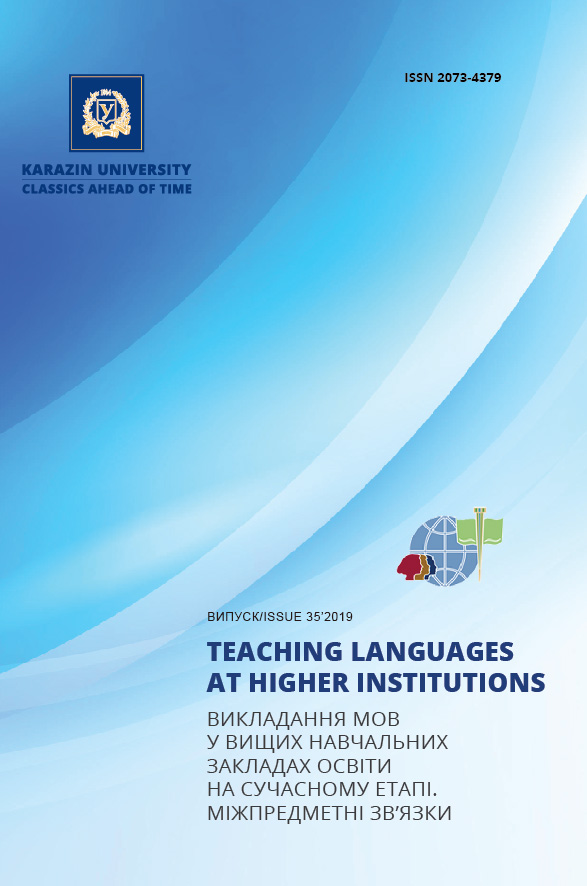Pedagogical grammar as the frameworkof tefl research.part 7. native language syntax acquisition: conceptual complexity
Abstract
The paper presents the results of the experimental data analysis in the said sphere. Basing upon a high degree of the data similarity, the author makes a conclusion that the native language (English) syntax acquisition is a rule-governed process with its specific stages. Taking into account the said data, the author also offers some assumptions concerning the content of stages in the process of tag questions, negation, passive constructions and relative clauses acquisition in English as a native language, as well as regarding the conditions of fully inverted tag questions emergence in the child’s speech and the potential catalysts of this process. The paper analyses the influence of the minimal proximity principle on the correct interpretation of relative clauses and those containing passive constructions by the young children of different age groups. The author offers an assumption concerning the gradual character of the acquisition of conceptually complicated syntactic categories, in particular, about the dissimilar transfer speed of the passive construction use rule to the verbs indicating actions, on the one hand, and states – on the other. The paper lists the factors affecting the sequence and speed of the syntactic means acquisition, which include the semantic and grammatical complexity, frequency of use and perceptual salience. The author generalizes the stages of syntax acquisition, which include the acquirement of the sentence structure elements linear sequence (where the notions of ‘precedence’ and ‘succession’ are acquired); the acquisition of the rules, which do not take into account the sentence structure; the primary consolidation of sentence elements in terms of their surface features; the identification of sentence components on the basis of the minimum proximity principle; the formulation of the rule, which takes into account the sentence structure and its expansion to a small class of words; the gradual expansion of the latter rule to the entire class of words. The paper outlines the prospects of further research concerning the development of pedagogical grammar, taking into account the abovementioned conclusions.
Downloads
References
Brown, R. (1973). A First Language: The Early Stages. Cambridge, Mass.: Harvard Univ. Press [in English].
Chernovaty, L. (1999). Osnovy teorii pedagogicheskoi grammatiki inostrannogo yazyka [The Basics of the Foreign Language Pedagogical Grammar Theory]. Doctor of Sciences thesis. Kharkiv: V.N. Karazin Kharkiv National University [in Russian].
Chernovaty, L.M. (2018). Pedagogical grammar as the framework of research in teaching foreign languages. Part 5. Native language morphology acquisition at the simple sentence stage. Vykladannia mov u vyshchykh navchalnykh zakladakh osvity na suchasnomu etapi. Mizhpredmetni zviazky [Teaching Languages at Higher Institutions], 33, pp. 118–126 [in English].
Chernovaty, L.M. (2018). Pedagogical grammar as the framework of research in teaching foreign languages. Part 6. Native language syntax acquisition: yes-no- and why-questions. Vykladannia mov u vyshchykh navchalnykh zakladakh osvity na suchasnomu etapi. Mizhpredmetni zviazky [Teaching Languages at Higher Institutions], 34, pp. 246–257 [in English].
Chierchia, G., Crain, S., Guasti, M., Gualmini, A. and Meroni, L. (2000). The acquisition of disjunction: Evidence for a grammatical view of scalar implicatures. Proceedings of the 25th Boston University Conference of Language Development. Somerville, MA: Cascadilla Press, pp. 157–168 [in English].
Crain, S., Gardner, A., Gualmini, A.and Rabbin, B. (2002). Children’s command of negation. Yukio Otsu (Ed.). Proceedings of the third Tokyo Conference on Psycholinguistics. Tokyo: Hituzi Publishing Company, pp. 71–95 [in English].
Crain, S., Goro, T. and Thornton, R. (2006). Language Acquisition is Language Change. Journal of Psycholinguistic Research, 35 (1), pp. 31–49. DOI: 10.1007/s10936-005-9002-7 [in English].
de Villiers, J. and de Villiers, P. (1978). Language Acquisition. Cambridge, Mass.: Harvard Univ. Press [in English].
Dimroth, Ch. (2010). The acquisition of negation. Horn, L.R. (Ed.). The expression of negation. Berlin: De Gruyter Mouton, pp. 39–73. DOI: 10.1515/9783110219302.39 [in English].
Erreich, A., Valian, V. and Winzemer, J. (1980). Aspects of a theory of language acquisition. Journal of Child Language, 2, pp. 157–179 [in English].
Goro, T. and Akiba, S. (2004). The acquisition of disjunction and positive polarity in Japanese. Garding, G. and Tsujimura, M. (Eds.). Proceedings of WCCFL 23. Somerville, MA: Cascadilla Press, pp. 101–114 [in English].
Gualmini, A., Crain, S. and Meroni, L. (2000). Acquisition of disjunction in conditional sentences. Proceedings of the 24th Boston University Conference of Language Development. Somerville, MA: Cascadilla Press, pp. 367–378 [in English].
Ingram, D. (1992). First Language Acquisition. Cambridge: Cambridge Univ. Press [in English].
Islam, Y. (2015). Phases in L1 Acquisition of Negation: A Comparative Study of Cairene Arabic and English. SKASE Journal of Theoretical Linguistics, 12 (4), pp. 17–27 [in English].
Kusmanto, J., and Pulungan, A. (2003). The acquisition of English negation “no” and “not”: evidences from an Indonesian child in non-native parents bilingual program. K@ta: a Biannual Publication on the Study of Language and Literature, 5 (1), pp. 41–48 [in English].
Notley, A., Zhou P., Jensen B. and Crain, S. (2012). Children’s interpretation of disjunction in the scope of “before”: A comparison of English and Mandarin. Journal of Child Language, 39 (3), pp. 482–522 [in English].
Tieu, L., Yatsushiro, K., Cremers, A., Romoli, J., Sauerland, U. and Chemla, E. (2017). On the Role of Alternatives in the Acquisition of Simple and Complex Disjunctions in French and Japanese. Journal of Semantics, 34 (1), pp. 127–152. Available at: https://doi.org/10.1093/jos/ffw010 [in English].

